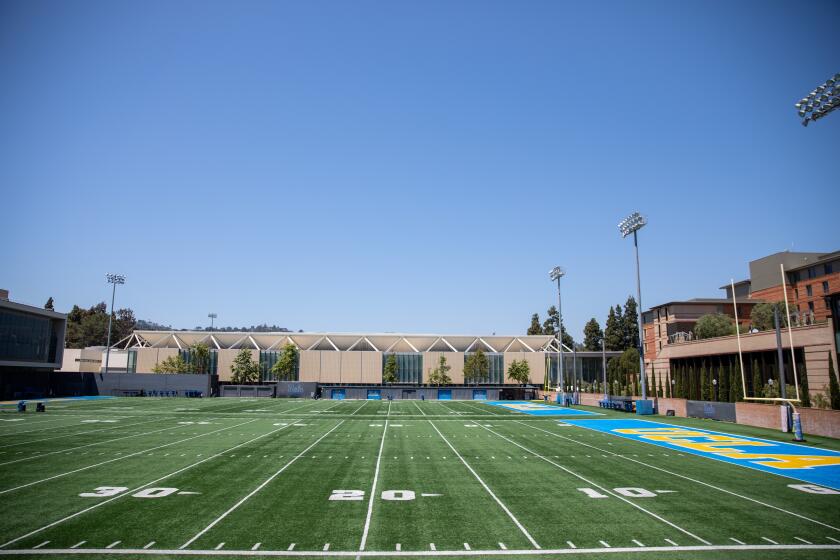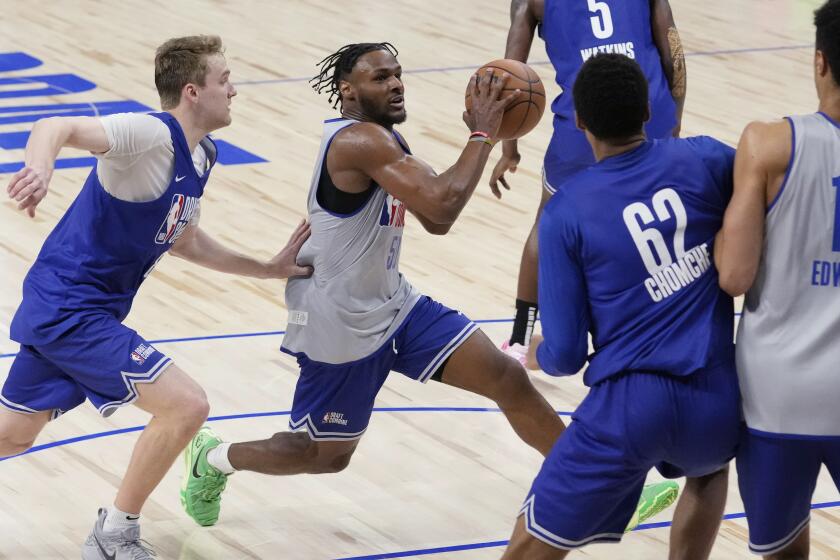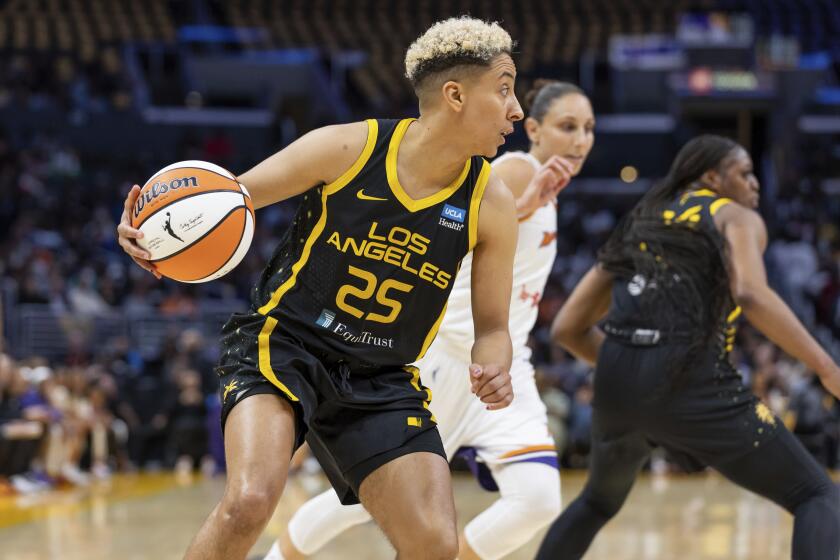THE HIGH AND THE MIGHTY : Tall Players Are Reaching New Heights in Versatility and Respectability
The coaching techniques used to be simple for a high school player 6-feet 8-inches or taller--for those lucky enough to have a player that tall.
OK, Stretch, just stand here, put your arms up as high as you can and we’ll throw you the ball.
Of course, that was the easy part.
No, Stretch, don’t dribble. Do NOT put the ball on the floor. Just shoot. That’s it. But next time, you might want to turn and face the basket.
Teaching defense was easier.
Stand in the key, Stretch. Put your arms out. Good D. Now, if the ball comes your way, grab it!
In those days, coaches neither asked nor expected too much from the tall guys.
“It used to be if you had a guy 6-8, he was going to be a walking zombie,” said Dick Katz, Westminster basketball coach.
But those were the old days, like, maybe, seven or eight years ago.
These days, it’s common for a 6-8 player to be taking the ball upcourt, shooting from the outside, filling lanes on the fast break and contributing to the fullcourt press.
Kevin Walker, Brea-Olinda’s 6-10 center, is one of the Wildcats’ best shooters, and regularly scores on 18-foot jumpers. Bob Erbst, Katella’s 6-9 forward, could probably play point guard.
Stuart Thomas, Mater Dei’s 6-9 forward, played wing last season, and has a good touch from 17 feet. John Waikle, Capistrano Valley’s 6-9 forward, plays an integral part in the Cougars’ fast-break offense, and also is a good shooter.
Gene Lloyd, Brea-Olinda coach, recalled a season 11 years ago when there were about 10 Southern California players in the 6-10 range. Lloyd said none of them, including Wildcat center Barry Weston, was asked to do much more than play defense in the middle of a zone. Very few were involved with the fast break, and most played offense with their backs to the basket.
“But after watching the Sonora Tournament (last week) with three of the top big men in the Southern Section, Erbst, Walker and (Hacienda Heights Wilson’s) Scott Williams, I thought, what a difference in the past 11 years,” Lloyd said.
“Those kids are bringing the ball up court, filling lanes, going to the basket with authority from half-court and stealing passes on the press. Those things were unheard of five years ago. The kids have gotten that much better.”
Several factors have contributed to the rise of the big man, one being that there are simply more of them. Naturally, a greater number of players will produce a greater number of more talented and mobile players. In Orange County this season, there are 10 varsity players who stand 6-8 or taller.
“And some of the real tall guys are as coordinated as guards,” Katz said.
Another factor has been the breakdown of the position barrier. Perhaps two players, Magic Johnson and Larry Bird, are most responsible.
Johnson and Bird, both 6-9, have transcended the game’s traditional positions, thereby helping to re-define the big man’s role.
They can dribble, pass, shoot from the outside, rebound, and post up and score from the inside. Johnson had 563 assists during the 1979-80 season. He also played center in place of the injured Kareem Abdul-Jabbar, and scored 42 points in the sixth and deciding game of the Lakers championship-series win over Philadelphia.
Bird was the NBA Rookie of the Year in 1980. Johnson was named Most Valuable Player of the Championship Series.
“I think Bird influenced me the most, because I’m not a super quick guy like Johnson,” Thomas said. “Larry is fundamentally sound. Before them, it was always Kareem Abdul-Jabbar. I had a sky hook when I was in sixth grade. If Magic played back then, I probably would have done more dribbling.”
Walker said he was influenced by Ralph Sampson, the Houston Rockets’ 7-4 forward who loves to shoot from the outside and dribble on the fast break.
“He’s really the only guy I’ve paid attention to,” Walker said. “He shoots from 19 feet and takes the ball up the floor. I used to have a hook shot, but I’d rather shoot jumpers from the outside.”
These professionals weren’t the first versatile big men, but they probably did the most to eliminate the tall-player stereotype.
When Johnny Rogers was a 6-8 junior at Westminster during the 1979-80 season, he wasn’t comfortable playing inside, so Katz let him shoot from the outside.
“We were criticized because he was the biggest guy on the team and he was shooting from outside,” Katz said. “Some people thought because he was the biggest, he should play inside.”
Rogers, a starting forward at UC Irvine, led the Anteaters in scoring last season and is one of their best shooters.
Though players such as Erbst and Walker can do it all, there still is room for Stretch. Meet Lee Velasquez, Rancho Alamitos’ 7-1 center, and Mike Kotzin, Buena Park’s 6-8 center.
In basketball vernacular, they’re known as projects.
Both began their careers as awkward, immobile players, but both have improved immensely since their freshman years. Velasquez blocked 119 shots last season, and Kotzin is a starter for the Coyotes.
“I’m a lot quicker this year,” said Velasquez, the county’s tallest player. “My rebounding is getting stronger, and I think this will be my best season.”
A few years ago, Velasquez said he could barely stand up straight when he walked.
Kotzin spent his first two years on the junior varsity and saw limited varsity action last season. Coyote Coach Ken Bell doesn’t think he’ll reach his potential for at least another two years.
“He’s not real mobile, and he’s not real good at getting up and down the floor,” Bell said. “He grew so fast, he doesn’t have all his coordination. But each year, he’s worked real hard at jumping rope and has improved his quickness.
Now, he’s a tough inside player who is averaging three blocked shots a game.”
Such players are brought along slowly. Mark Georgeson, Marina’s 6-9 junior, was so uncoordinated in eighth grade that he failed to make the junior high team. When he first started playing the summer before his freshman year, he fouled out of most games.
He played on the sophomore team as a freshman, and Viking Coach Steve Popovich moved him to the varsity as a sophomore. This season, he’s a starter averaging 14 points and 7 rebounds a game, and Popovich projects Georgeson to be a college prospect.
Velasquez, Kotzin and Georgeson may not have the skills to play point guard, but there is definitely room for them.
“Defensively, people have to look at them because they can be intimidating inside,” said Popovich, the 6-6 coach who played basketball at the University of Wyoming. “I played against Lew Alcindor (Abdul-Jabbar) in college and I was always looking around for him. They force teams to either sag in on them or put a lot of pressure on the pass going in. You have to be cognizant of a big guy.”
Coaches, meanwhile, have to be cognizant of the fact that big men have special problems.
How’s the weather up there? Do you play basketball?
Just two of the questions tall people often are asked, but even worse is the constant pressure that comes with being so tall. People expect you to score a lot of points, control the game under the boards, block a lot of shots, and win, win, win.
That can be tough for a teen-ager just learning to cope with his height.
“I found you have to be patient with tall players, because bigger guys tend to be more self-conscious,” Katz said. “When you’re that tall, you always have the feeling someone is watching you. If you mess up, everyone notices.”
Even though Velasquez helped Rancho Alamitos win its first Garden Grove League championship in more than 10 years last season, the pressure became so great that the center wept after some games.
“I know people expect me to do a lot,” said Velasquez, who was an all-league, first-team selection. “If I didn’t do all I thought I could, I really felt bad. Even if we won.”
There are times Velasquez wishes he wasn’t seven feet tall. He gets tired of the gawks and the stupid questions.
“It can really get to you, but I’m learning how to deal with it,” he said. “You have to or you’d go crazy, because you’re going to hear it your whole life.”
Said Thomas: “A lot of people look at you as if you’re a freak or something, but it (height) has its advantages, like when you’re looking for someone in a crowd, you can usually spot them out. The disadvantage is that it’s tough not to be seen, especially when the dean is looking for you.”
There are other problems. Walker instinctively ducks through every door. Even if there’s plenty of room, he’ll flinch because he’s hit his head so many times. Erbst and Waikle must buy pants at big and tall shops, where clothes usually are more expensive.
Erbst has to order shoes for his size 15 feet at least a month in advance. So does Waikle, who wears a size 15 1/2. Velasquez gets his size 21 sneakers from Utah Jazz center Mark Eaton, a friend who played at UCLA and went to high school at Westminster.
Waikle also would love to drive a small sports car, but it’s tough when your knees are pinned against the dashboard.
For the most part, though, after players learn to live with their height, they seem to appreciate it.
“I’m proud of my height,” said Waikle, who has signed a letter of intent to play at Weber State.
“It has gotten me where I am and where I can go from here,” said Walker, who will attend UCLA on a scholarship next year.
“It pays off,” said Erbst, headed for USC.
Georgeson has a year to go before he receives any scholarship offers, but he still has plenty of self-esteem.
“I used to slouch over in the fifth and sixth grade, but now I stand up straight,” he said.
The 6-8 and Over Club
Name School Height John Arabia Servite 6-8 LeRon Ellis Mater Dei 6-10 Bob Erbst Katella 6-9 Mark Georgeson Marina 6-9 Brian Joe La Quinta 6-8 Mike Kotzin Buena Park 6-8 Stuart Thomas Mater Dei 6-9 John Waikle Capistrano Valley 6-9 Kevin Walker Brea-Olinda 6-10 Lee Velasquez Rancho Alamitos 7-1
More to Read
Get our high school sports newsletter
Prep Rally is devoted to the SoCal high school sports experience, bringing you scores, stories and a behind-the-scenes look at what makes prep sports so popular.
You may occasionally receive promotional content from the Los Angeles Times.







